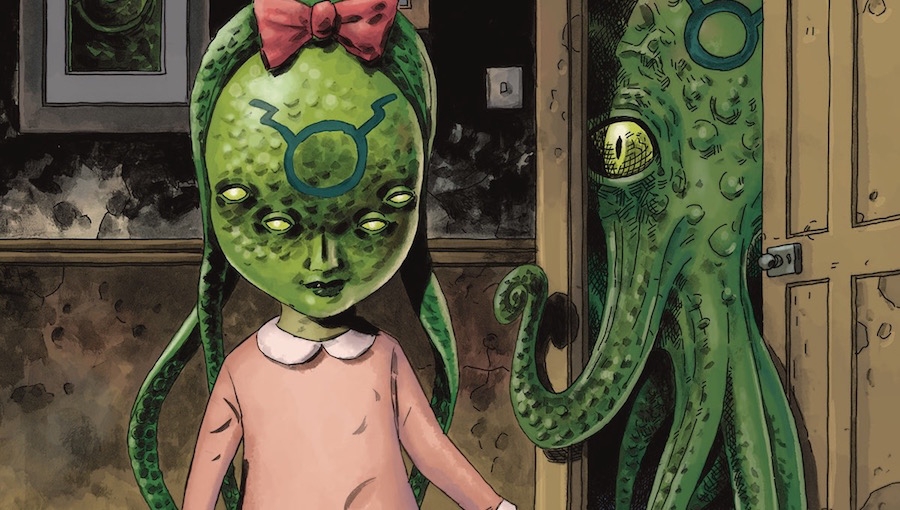Sherlock Frankenstein and the Legion of Evil is a four-issue miniseries and spinoff from Dark Horse’s Black Hammer series. With the original run of Black Hammer ending at issue thirteen, planning to be resumed with a new series titled Black Hammer: Age of Doom in the spring of 2018, Sherlock Frankenstein acts as stop gap for fans of the series, approaching the Black Hammer world with emphasis on its villains. The original Black Hammer saw Spiral City’s superheroes vanish to a rural farm in an alternate dimension after defeating the Anti-God. Sherlock Frankenstein sees Lucy Weber, the daughter of Black Hammer and also reporter for The Global Planet, investigating the disappearances by questioning the various supervillains of the city, who were left with no adversaries.
In issue two, “The Call of Cthu-Lou!,” Lucy interviews the titular Cthu-Lou, a plumber turned into a green-octopus-headed Cthulhu spawn, who was a villain of Spiral City for a period. The first half the issue provides the backstory of how Cthu-Lou came to be (He was lured into a sewer, eaten by Cthulhu, and spit out, forever changed.) while the last half of the issue has Lucy interviewing him, hoping to find new leads in regards to the disappearance of her dad and the other superheros. (She does.) All the while, Cthu-Lou’s dominating wife brokers the interview, demanding a large payment, and directing her anger and ire at Lucy, Cthu-Lou, and even her daughter, Cthu-Louise.
The cover of issue two is definitely eye-catching, with a blue-collar depiction of a Cthulhu-monster, both evoking and countering the bespoke-suited Cthulhu on the infamous Cthulhu Unbound 2 short story anthology. Lovecraft purists who disdain the commodification of Cthulhu will no doubt shy away from the interpretation of the mythos in this issue, so this comic is not for them. As grotesque as the tentacled Cthu-Lou may be, his wife is far scarier, with the clichéd hair rolls and her face permanently contorted in anger. It’s uneasy to read when she is on the page. Cosmic fear takes the backseat to fear of the dysfunctional family.
David Rubín’s art style and coloring is on point and eye-catching, a gritty interpretation of a Nickelodeon cartoon. His sewer sequences almost look as if they could glow in the dark from all the green hues and slime akin to the classic Teenage Mutant Ninja Turtles cartoon; they look adventurous, as well as disgusting. Greens are the dominant color for the majority of the book (The sewer sequences seem to actually flow on the pages.), before switching to outrun magenta in the final few pages. The personalities of the characters really come through on their facial expressions which balance being cartoonish and emotive.
The detective work written by Jeff Lemire provides enough kernels to keep Lucy (and by extension the comic’s readers) invested and intrigued with the mystery. Cthu-Lou is adamant that his backstory is inconsequential and is skeptical that he is unable to provide any meaningful information to Lucy, but she is able to guide the dialogue to a new trail to pick up from, and of course, an issue-ending cliffhanger. The way the narrative is progressing, it is certainly exciting to see where Lucy’s investigation will take her next over the Sherlock Frankenstein run.
Nicholas Diak is a pop culture scholar of industrial and synthwave music, Italian genre films, and Lovecraft studies. He contributes essays to various anthologies, journals, and pop culture websites. He is the editor of the forthcoming anthology, The New Peplum: Essays on Sword and Sandal Films and Television Programs Since the 1990s. He can be found at nickdiak.com.

